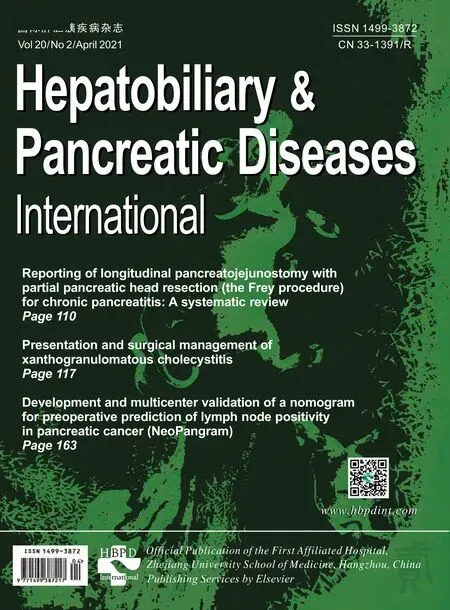A new nomogram for predicting lymph node positivity in pancreatic cancer
2021-11-26XiaoDongTianYinMoYang
Xiao-Dong Tian,Yin-Mo Yang
Department of General Surgery, Peking University First Hospital, Beijing 10 0 034, China
Pancreatic cancer (PC) is one of the most dismal malignancies,and radical resection in combination with perioperative systemic chemotherapy provides the only chance of long-term survival [1].However,surgeons have been increasingly aware that some anatomically resectable PC patients cannot benefit from upfront surgery.The majority of PC patients with radical resection will suffer from local recurrence or systematic metastasis in 1-2 years after surgery,especially for those with pathological positive lymph nodes (LNs) [2].Hence,the preoperative identification of PC patients with LN metastasis is essential for either prognosis prediction or administration of neoadjuvant chemotherapy or radiochemotherapy.However,it is reported that approximately 70%of PC patients who were clinically diagnosed as node negative finally proved to have nodal involvement upon pathological evaluation,indicating that the radiological staging of nodule involvement before surgery is still difficult [3].Therefore,the development of prediction models for preoperative determination of pathological LN positivity in resectable PC patients has potential significance for optimizing the individualized comprehensive treatment strategies before surgery.
Hua and colleagues are to be congratulated for producing a nomogram model to identify PC patients at high risk for positive LNs who may have more advanced disease and potentially benefit from neoadjuvant therapy [4].The nomogram consists of three predictors which could be easily obtained preoperatively:risk score of the four-marker signature (CA19-9,CA125,CA50,and CA242),CT-reported LN status,and clinical tumor stage.They have demonstrated that the prediction model exhibited good discrimination ability for the development,internal validation,and external validation cohorts.In addition,to further facilitate its clinical application,they set a threshold of LN metastasis (cut-off value of 0.72) to separate low-risk and high-risk patient groups,and produced a positive predictive value of 78.4%.
Compared with previously reported predictive methods using preoperative CT alone or in combination with CA19-9,the current predictive tool integrates more parameters including multiple tumor markers,CT-reported LN features and tumor size (clinical tumor stage),resulting in the most accurate predictive power to identify PC patients at high risk for LN metastasis [ 5,6 ].However,patients with severe obstructive jaundice may show false elevation of CA19-9,thus misleading the predictive results.And some of the tumor markers (CA125 and CA50) involved in this tool may not be routinely examined for suspicious PC patients in some centers.Moreover,the current predictive tool cannot differentiate N1 and N2 stage,which might be more constructive to the accurate preoperative assessment of the prognosis of PC patients.Nevertheless,the current predictive model provides improvement of individualized treatment strategies for resectable PC.We hope that in the near future,they could conduct prospective clinical trials guided with this model to further prove its significance,and to improve the overall survival of resected PC patients.
Acknowledgments
None.
CRediT authorship contribution statement
Xiao-Dong Tian:Investigation,Writing -original draft.Yin-Mo Yang:Conceptualization,Supervision,Writing -review &editing.
Funding
None.
Ethical approval
Not needed.
Competing interest
No benefits in any form have been received or will be received from a commercial party related directly or indirectly to the subject of this article.
杂志排行
Hepatobiliary & Pancreatic Diseases International的其它文章
- Meetings and Courses
- Novel 3D preclinical model systems with primary human liver cells:Recent progresses,applications and future prospects
- Comparison of the effects of retrieval balloons and basket catheters for bile duct stone removal on the rate of post-ERCP pancreatitis
- Double cystic duct without being aware of the anatomic anomaly during laparoscopic cholecystectomy:The first case of reverse Y type anomaly
- Novel mutation of the TJP2 gene in a Chinese child with progressive cholestatic liver disease coexistent with hearing impairment
- Acute cardiogenic liver injury caused by heart failure in an adolescent
